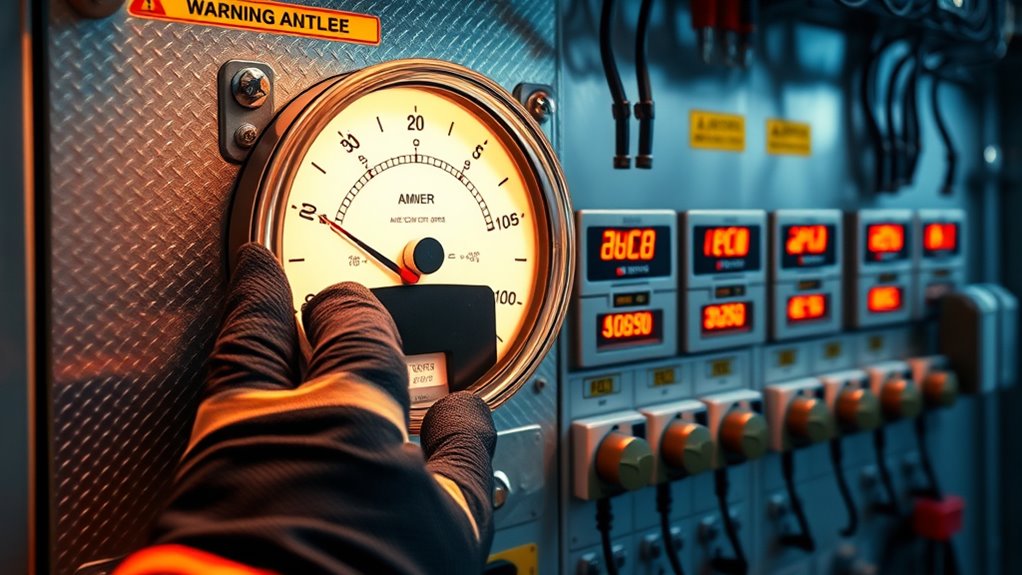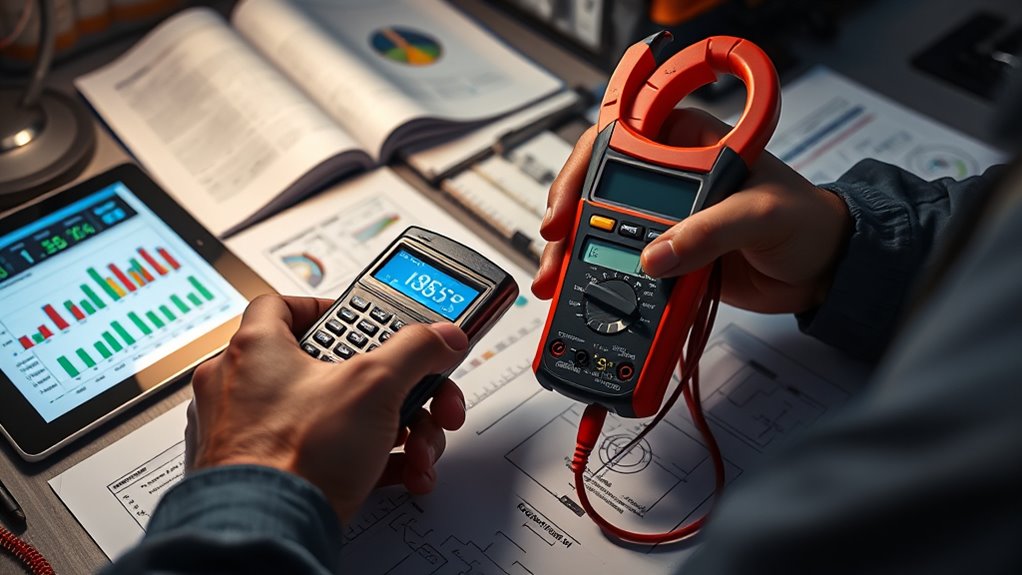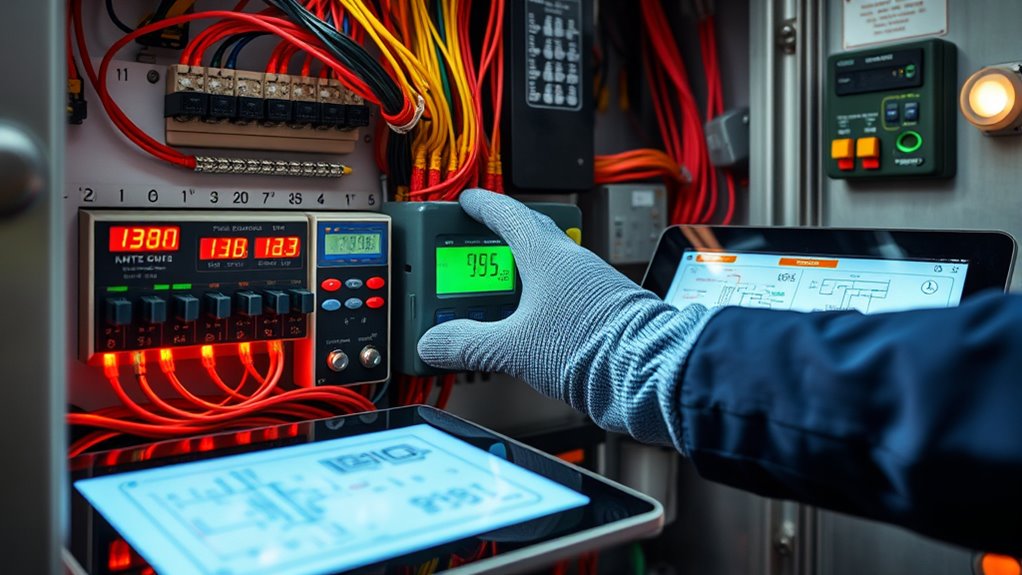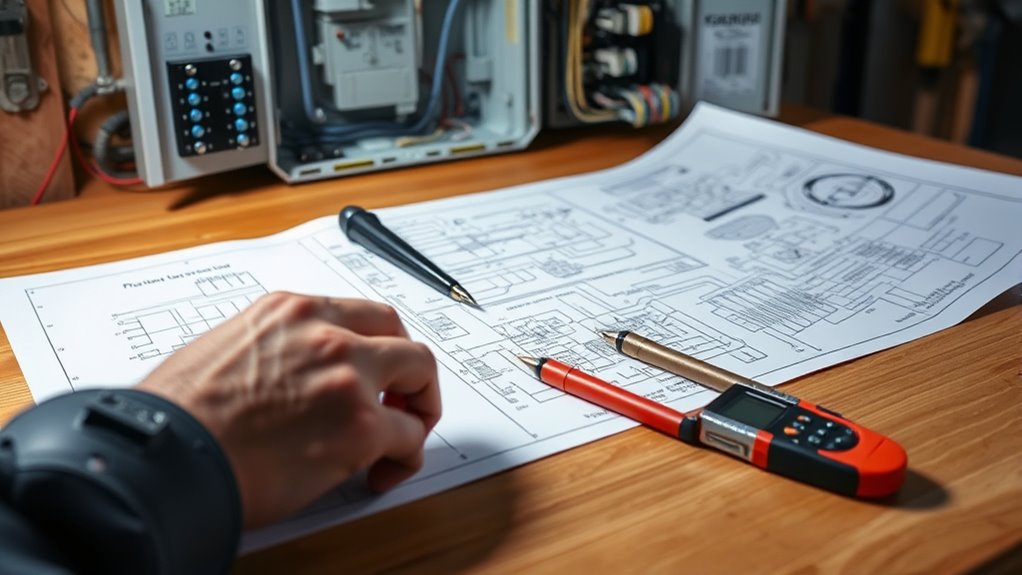After an outage, you must perform critical calculations to guarantee your system’s stability, safety, and efficiency. Check voltage levels to prevent damage, verify short-circuit current ratings for proper protection, and assess load currents and demand factors to avoid overloads. Evaluate power quality, harmonics, and power factor for ideal performance. Properly adjusting protective devices and inspecting insulation resistance are also essential. Continue exploring these vital steps to keep your electrical system reliable and safe.
Key Takeaways
- Verify voltage stability, ground faults, and arc flash risks to ensure safe system restart and prevent equipment damage.
- Calculate load currents and demand factors to confirm system capacity and identify peak demand periods.
- Check protective device ratings and settings, ensuring they can safely interrupt faults and are properly calibrated.
- Measure power factor and harmonic levels to maintain power quality and prevent equipment overheating or failure.
- Use specialized tools and AI security systems for ongoing anomaly detection and proactive maintenance post-outage.
Assessing System Voltage Stability

Evaluating system voltage stability is crucial after completing a power outage or maintenance. You need to confirm that voltage levels remain consistent to prevent equipment damage or operational issues. Start with ground fault detection, which helps identify any unexpected leaks or faults that could destabilize the system. Conducting an arc flash analysis is equally important; it assesses potential arc flash hazards that could jeopardize personnel safety and affect voltage stability. By analyzing these factors, you can detect anomalies early and take corrective actions before resuming normal operations. Proper assessment ensures the system can handle load demands without voltage fluctuations, safeguarding both equipment and personnel. Regular checks of ground faults and arc flash risks are essential steps in maintaining reliable, stable power after outages or maintenance. Additionally, understanding essential safety procedures can further enhance the effectiveness of your maintenance checks and prevent unforeseen issues.
Calculating Load Currents and Demand Factors

After verifying system stability and identifying any faults or hazards, calculating load currents and demand factors helps you determine whether the system can handle the expected electrical loads. Accurate load calculations guarantee you maintain energy efficiency and avoid overloads. To do this effectively:
- Measure individual device currents, considering their power factor, to estimate total load accurately.
- Apply demand factors to account for typical usage patterns, preventing overestimation.
- Review load profiles to identify peak demands and adjust capacity accordingly.
- Incorporate load profiles from various sources to better predict and manage fluctuating demands.
Understanding power factor’s influence on energy efficiency allows you to optimize system performance. Proper calculations help you ensure the system’s reliability, prevent unnecessary energy losses, and maintain safe operation after outages. This process is essential for effective post-outage electrical maintenance.
Verifying Short-Circuit Current Ratings

You need to verify the short-circuit current ratings to guarantee your equipment can handle potential fault conditions. Understanding these ratings helps you select compatible devices and prevent equipment damage. By confirming ratings, you keep your system safe and reliable during unexpected faults.
Understanding Short-Circuit Ratings
Understanding short-circuit ratings is essential for guaranteeing your electrical system’s safety and reliability. These ratings determine how much current equipment can handle during faults like ground faults or arc flashes without failure. To verify proper ratings, consider these key points:
- Check the maximum prospective short-circuit current at the point of installation to prevent equipment damage.
- Ensure protective devices are rated to interrupt fault currents safely and effectively.
- Confirm that all components can withstand the highest possible fault current, avoiding hazards during outages.
- Keep in mind that short-circuit ratings are often specified by manufacturers and must be matched with system requirements for optimal safety.
Ensuring Equipment Compatibility
Ensuring equipment compatibility requires verifying that all components can handle the maximum short-circuit current at their installation points. Start by reviewing the short-circuit current ratings of your grounding systems, confirming they can safely withstand fault conditions without damage. Check wiring configurations to verify they meet the required ratings, preventing potential overloads. Proper grounding systems are essential for safely directing fault currents, so confirm their ratings align with system demands. When evaluating equipment, ensure that circuit breakers, fuses, and protective devices are rated for the maximum fault current. Compatibility between components reduces risk and ensures safety during outages. Always cross-reference manufacturer specifications and standards to avoid mismatches, which could lead to equipment failure or hazards during a fault. Additionally, understanding the dynamic nature of short-circuit currents helps in designing systems that can adapt to varying fault conditions safely.
Performing Power Factor and Energy Efficiency Checks

Have you ever wondered why maintaining essential power factor and energy efficiency after an outage is crucial? Proper checks ensure systems run smoothly, prevent equipment damage, and reduce operational costs. To evaluate this effectively, consider these key steps:
- Measure your current power factor using a reliable meter to identify if it’s below optimal levels.
- Calculate energy efficiency by comparing input energy to useful output, pinpointing losses.
- Adjust capacitor banks or other power correction devices to improve power factor, which directly enhances energy efficiency.
Focusing on these calculations helps you maintain system stability, avoid penalties, and extend equipment lifespan. Regularly performing these checks ensures you keep your electrical system operating at peak efficiency post-outage.
Inspecting Protective Device Settings

After an outage, inspecting protective device settings is essential to confirm they will operate correctly when needed. Begin by verifying the protective device calibration to ensure trip points are accurate according to manufacturer specifications and system requirements. Check the wiring configuration to confirm all connections are correct and securely attached, preventing false trips or missed faults. Pay close attention to settings such as relay pickup currents, time delays, and coordination with other protective devices. Any discrepancies could compromise system safety and reliability. Record your findings and adjust settings if needed, ensuring they match the original design parameters. Proper inspection and calibration help maintain ideal protection, reduce false alarms, and ensure the system responds appropriately during future faults. Additionally, staying aware of AI vulnerabilities can inform maintenance practices and safety protocols with emerging technological insights.
Evaluating Insulation Resistance and Continuity

Evaluating insulation resistance and continuity is crucial for verifying the integrity of electrical circuits following an outage. Proper testing helps identify issues like ground faults and insulation degradation that could cause future failures. To guarantee safety and reliability, focus on these key steps:
- Measure insulation resistance across conductors and ground to detect low-resistance paths indicating potential ground faults or insulation breakdown.
- Check continuity in circuits to confirm connections are intact and components are properly linked.
- Look for signs of insulation degradation, which can lead to increased leakage currents and reduced resistance, risking faults down the line.
- Incorporate automation in testing procedures to ensure thorough and consistent diagnostics, improving overall maintenance efficiency.
Analyzing Transient and Harmonic Distortions

You need to identify transient events quickly, as they can cause equipment damage or false readings. Evaluating harmonic levels helps guarantee power quality remains within acceptable limits. By focusing on these points, you can prevent potential failures and improve system reliability. Incorporating AI security technologies can further enhance your ability to detect unusual patterns and respond proactively to power anomalies.
Detecting Transient Events
How can you effectively identify transient events that occur suddenly and disrupt normal power system operation? You need to monitor your system with proper tools and adhere to safety protocols. Quick detection minimizes damage and guarantees safety. To do this effectively: 1. Use high-speed oscilloscopes or transient recorders to capture sudden voltage or current spikes. 2. Train your team on recognizing signs of transient events, fulfilling training requirements for accurate interpretation. 3. Regularly inspect and calibrate your measurement equipment to maintain detection accuracy. Additionally, understanding harmonic distortions can help differentiate between transient events and other power quality issues, leading to more precise diagnostics.
Assessing Harmonic Levels
Harmonic distortions can substantially impact power quality, making it essential to measure and analyze harmonic levels accurately. Excessive power harmonics cause equipment overheating, vibrations, and efficiency losses. To perform effective distortion analysis, you need to identify the sources and levels of harmonics present. Use specialized meters to record harmonic currents and voltages across different frequencies. The table below summarizes key concepts:
| Aspect | Description | Impact |
|---|---|---|
| Power Harmonics | Unwanted frequencies in the system | Equipment stress, inefficiency |
| Harmonic Levels | Magnitude of harmonic distortion | Power quality degradation |
| Distortion Analysis | Process of evaluating harmonic content | Ensures compliance and safety |
Regular assessment of harmonic levels helps maintain reliable power systems and prevents costly damage. Quality meters are essential tools in this process to ensure accurate readings and effective mitigation strategies.
Frequently Asked Questions
How Often Should Post-Outage Electrical Checks Be Performed?
You should perform post-outage electrical checks immediately after restoring power and then regularly, based on your facility’s preventive measures and inspection protocols. Typically, inspections are done within 24 to 48 hours after an outage, and then at scheduled intervals—weekly or monthly—depending on equipment criticality. Consistent checks guarantee safety, prevent damage, and maintain compliance. Always tailor your inspection schedule to the specific requirements of your electrical system and operational standards.
What Safety Precautions Are Essential During These Maintenance Checks?
During maintenance checks, you must wear appropriate personal protective equipment, including gloves, safety glasses, and insulated tools. Conduct a hazard assessment beforehand to identify potential electrical risks. Guarantee all equipment is properly grounded, de-energized, and verified before starting work. Follow safety protocols strictly, stay alert for unexpected faults, and communicate with your team. These precautions protect you from electric shocks, arc flashes, and other hazards, ensuring a safe and effective maintenance process.
How Do Environmental Factors Influence Electrical System Recovery?
Think of your electrical system as a delicate garden. Climate impact, like wind or temperature swings, can stress the plants, just as environmental factors strain your system. Moisture effects, such as rain or humidity, can cause corrosion or short circuits, hindering recovery. By monitoring these factors, you guarantee your system’s resilience, allowing it to rebound stronger after outages—much like a well-cared-for garden flourishes despite weather challenges.
What Are Common Signs of Underlying Electrical Issues Post-Outage?
You should look out for signs like unexpected power surges, which indicate electrical instability, and insulation failure, evident through exposed wiring or frequent breaker trips. These issues often stem from underlying problems caused by environmental factors or system stress. If you notice these signs after an outage, it’s vital to perform thorough checks to prevent further damage or potential hazards. Addressing these early guarantees your electrical system remains safe and reliable.
How Can Predictive Analytics Improve Outage Maintenance Accuracy?
Think of predictive analytics as your electrical maintenance crystal ball. By using predictive modeling, you can forecast failures before they happen, much like catching a storm before it hits. This proactive approach boosts outage maintenance accuracy, reducing downtime and costs. With failure forecasting, you’re not just reacting to problems—you’re anticipating them, turning maintenance from a reactive chore into a strategic tool that keeps your power grid resilient and reliable.
Conclusion
Think of your electrical system as a finely tuned orchestra; every instrument must be in harmony after an outage. Skipping these essential checks risks discord—voltage drops, overloads, or faults could strike unexpectedly. By diligently performing these calculations and inspections, you’re guiding your system back to its symphony of efficiency and safety. Don’t let silence fall again—be the conductor who keeps the power flowing smoothly.









